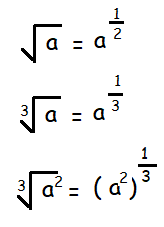CONVERTING RADICAL TO EXPONENTIAL FORM
To convert radical to exponential form, let us first consider the equivalent form of radical.

Convert the radical form to exponential form :
Problem 1 :
(5√x)3
Solution :
5th root can be written as power 1/5.
(5√x)3 = (x1/5)3
To simplify the term, which is having a power raised to another power, we can multiply the powers.
(5√x)3 = x(1/5) x 3
= x3/5
Problem 2 :
(3√y4)
Solution :
Cube root can be written as power 1/3.
(3√y4) = (y4)1/3
= y4/3
Problem 3 :
(√x5)
Solution :
Square root can be written as power 1/2.
(√x5) = (x5)1/2
= x5/2
Problem 4 :
(3√5)3
Solution :
Cube root can be written as power 1/3.
(3√5)3 = (5(1/3))3
= 53/3
= 5
Problem 5 :
√(16x2)
Solution :
Square root can be written as power 1/2.
√(16x2) = (16x2)1/2
16 can be written as 42
√(16x2) = (42x2)1/2
= ((4x)2)1/2
= (4x)2 ⋅ (1/2)
= 4x
Problem 6 :
1/(√(6x))3
Solution :
Square root can be written as power 1/2.
1/(√(6x))3 = 1/[(6x)1/2]3
= 1/(6x)(1/2) x 3
= 1/(6x)(3/2)
When we move the term from numerator to denominator or denominator to numerator, we have to change the sign of the power.
= (6x)-3/2
Problem 7 :
1/(4√x)7
Solution :
Fourth root can be written as power 1/4.
1/(4√x)7 = 1/(x1/4)7
= 1/x(1/4) ⋅ 7
= 1/x(7/4)
= x-7/4
Problem 8 :
1/√(5x)
Solution :
Square root can be written as power 1/2.
1/√(5x) = 1/(5x)1/2
= (5x)-1/2
Kindly mail your feedback to v4formath@gmail.com
We always appreciate your feedback.
©All rights reserved. onlinemath4all.com
Recent Articles
-
Digital SAT Math Problems and Solutions (Part - 150)
Apr 25, 25 11:46 AM
Digital SAT Math Problems and Solutions (Part - 150) -
AP Calculus AB Problems with Solutions (Part - 19)
Apr 24, 25 11:10 PM
AP Calculus AB Problems with Solutions (Part - 19) -
AP Calculus AB Problems with Solutions (Part - 18)
Apr 24, 25 11:06 PM
AP Calculus AB Problems with Solutions (Part - 18)
